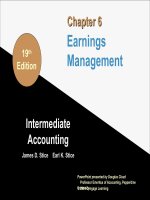Management by chuch williams chapter 06
Bạn đang xem bản rút gọn của tài liệu. Xem và tải ngay bản đầy đủ của tài liệu tại đây (610.94 KB, 33 trang )
Chapter 6
Organizational Strategy
MGMT
Chuck Williams
Designed & Prepared by
B-books, Ltd.
1
Copyright ©2008 Cengage Learning. All rights reserved
Basics of Organizational
Strategy
After reading these sections,
you should be able to:
1. indicate the components of sustainable
competitive advantage and explain why it is
important.
2. describe the steps involved in the
strategy-making process.
2
Copyright ©2008 Cengage Learning. All rights reserved
Sustainable Competitive Advantage
Resources
Resources
The
Theassets,
assets,capabilities,
capabilities,processes,
processes,
information,
information,and
andknowledge
knowledgethat
thatthe
the
organization
organizationcontrols
controls
Competitive
Competitive
Advantage
Advantage
Providing
Providinggreater
greatervalue
valuefor
forcustomers
customers
than
thancompetitors
competitorscan
can
Sustainable
Sustainable
Competitive
Competitive
Advantage
Advantage
AAcompetitive
competitiveadvantage
advantagethat
thatother
other
companies
companieshave
havetried
triedunsuccessfully
unsuccessfully
to
toduplicate
duplicate
1
3
Copyright ©2008 Cengage Learning. All rights reserved
Requirements for Sustainable
Competitive Advantage
Valuable
Valuable
Resources
Resources
Rare
Rare
Resources
Resources
Sustainable
Sustainable
Competitive
Competitive
Advantage
Advantage
Imperfectly
Imperfectly
Imitable
Imitable
Resources
Resources
NonNonSubstitutable
Substitutable
Resources
Resources
1
4
Copyright ©2008 Cengage Learning. All rights reserved
Strategy-Making Process
Assess need
for
strategic change
Conduct a
Situational
Analysis
Choose
Strategic
Alternatives
2
5
Copyright ©2008 Cengage Learning. All rights reserved
Assessing the Need
for Strategic Change
1. Avoid Competitive Inertia
a reluctance to change strategies or competitive
practices that have been successful in the past
2. Look for Strategic Dissonance
a discrepancy between a company’s intended strategy
and the strategic actions managers take when
implementing that strategy
2.1
6
Copyright ©2008 Cengage Learning. All rights reserved
Situational Analysis
SS
Strengths
Strengths
Internal
W
W
Weaknesses
Weaknesses
O
O
Opportunities
Opportunities
External
TT
Threats
Threats
2.2
7
Copyright ©2008 Cengage Learning. All rights reserved
Situational Analysis
I
N
T
E
R
N
A
L
Strengths
• Distinctive
Competence
• Core Capability
Weaknesses
E
X
T
E
R
N
A
L
Opportunities
• Environmental
Scanning
• Strategic Groups
Threats
2.2
8
Copyright ©2008 Cengage Learning. All rights reserved
Strategic Groups
• Core Firms
• central companies in a strategic group
• Secondary Firms
• firms that follow related, but somewhat different,
strategies than do core firms
2.2
9
Copyright ©2008 Cengage Learning. All rights reserved
Choosing Strategic Alternatives
• Risk-Avoiding Strategy
– protect an existing
competitive advantage
• Risk-Seeking Strategy
– extend or create a sustainable
competitive advantage
• Strategic Reference Points
– targets used by managers to determine if
the firm has developed the core
competencies it needs to achieve a
sustainable competitive advantage
2.3
10
Copyright ©2008 Cengage Learning. All rights reserved
Strategic Reference Points
2.3
11
Copyright ©2008 Cengage Learning. All rights reserved
Corporate, Industry, and
Firm-Level Strategies
After reading these sections,
you should be able to:
3. explain the different kinds of corporate-level
strategies.
4. describe the different kinds of industry-level
strategies.
5. explain the components and kinds of firm-level
strategies.
12
Copyright ©2008 Cengage Learning. All rights reserved
Corporate-Level Strategies
The
Theoverall
overallorganizational
organizationalstrategy
strategy
Corporate-Level
Corporate-Level that
thataddresses
addressesthe
thequestion
question“What
“What
Strategy
business(es)
Strategy
business(es)are
arewe
wein
inor
orshould
shouldwe
we
be
bein?”
in?”
3
13
Copyright ©2008 Cengage Learning. All rights reserved
Corporate-Level Strategies
PORTFOLIO STRATEGY
Acquisitions,
Acquisitions,
unrelated
unrelateddiversification,
diversification,
related
relateddiversification,
diversification,
single
singlebusinesses
businesses
BCG
BCGMatrix
Matrix
Stars
Stars
Question
Questionmarks
marks
Cash
Cashcows
cows
Dogs
Dogs
GRAND STRATEGIES
Growth
Growth
Stability
Stability
Retrenchment/
Retrenchment/
recovery
recovery
3
14
Copyright ©2008 Cengage Learning. All rights reserved
Market Growth
BCG Matrix
3.1
High
Question Marks
Stars
Low
Dogs
Cash Cows
Small
Large
Relative Market Share
Copyright ©2008 Cengage Learning. All rights reserved
15
BCG Matrix
3.1
Stars
Stars
companies
companieswith
withaalarge
large share
share
of
of aafast-growing
fast-growingmarket
market
Question
Question
Marks
Marks
companies
companieswith
withaasmall
smallshare
share
of
of aafast-growing
fast-growingmarket
market
Cash
Cash
Cows
Cows
companies
companieswith
withaalarge
large share
share
of
of aaslow-growing
slow-growingmarket
market
Dogs
Dogs
companies
companieswith
withaasmall
smallshare
share
of
of aaslow-growing
slow-growingmarket
market
16
Copyright ©2008 Cengage Learning. All rights reserved
BCG Matrix
Company D
Market Growth
Company A
High
Question Marks
Company G
Dogs
Company H
3.1
Company C
Company B
Low
Stars
Question Marks
Small
Company E
Cash Cows
Company F
Large
Relative Market Share
Adapted from Exhibit 6.3
Copyright ©2008 Cengage Learning. All rights reserved
17
Diversification and Risk
Risk
High
Relationship Between
Diversification and Risk
Low
Single
Business
Related
Diversification
Unrelated
Diversification
3.1
18
Copyright ©2008 Cengage Learning. All rights reserved
Problems with Portfolio Strategy
• Unrelated diversification does not reduce risk.
• Present performance is used to predict future
performance.
• Cash cows fail to aggressively pursue opportunities
and defend themselves from threats.
• Being labeled a “cash cow” can hurt employee morale.
• Companies often overpay to acquire stars.
• Acquiring firms often treat stars as “conquered foes.”
19
Copyright ©2008 Cengage Learning. All rights reserved
Grand Strategies
Growth
Growth
Strategy
Strategy
focuses
focuseson
onincreasing
increasingprofits,
profits,
revenues,
revenues,market
marketshare,
share,or
ornumber
number
of
ofplaces
placesto
todo
dobusiness
business
Stability
Stability
Strategy
Strategy
focuses
focuseson
onimproving
improvingthe
theway
waythe
the
company
companysells
sellsthe
thesame
sameproducts
products
or
orservices
servicesto
tothe
thesame
samecustomers
customers
Retrenchment
Retrenchment
Strategy
Strategy
focuses
focuseson
onturning
turningaround
aroundvery
verypoor
poor
company
companyperformance
performanceby
byshrinking
shrinking
the
thesize
sizeor
orscope
scopeof
ofthe
thebusiness
business
3.2
20
Copyright ©2008 Cengage Learning. All rights reserved
Industry-Level Strategies
Five
Five
Industry
IndustryForces
Forces
Positioning
Positioning
Strategies
Strategies
Adaptive
Adaptive
Strategies
Strategies
4
21
Copyright ©2008 Cengage Learning. All rights reserved
Porter’s Five Industry Forces
Threats
Threats of
of
New
NewEntrants
Entrants
Bargaining
Bargaining
Power
Powerof
of
Suppliers
Suppliers
4.1
Character
Character
of
of
Rivalry
Rivalry
Bargaining
Bargaining
Power
Power of
of
Buyers
Buyers
Threat
Threatof
of
Substitutes
Substitutes
22
Copyright ©2008 Cengage Learning. All rights reserved
Positioning Strategies
Cost
CostLeadership
Leadership
Differentiation
Differentiation
Focus
Focus Strategy
Strategy
4.2
23
Copyright ©2008 Cengage Learning. All rights reserved
Differentiation
24
Copyright ©2008 Cengage Learning. All rights reserved
Adaptive Strategies
Defenders
Defenders
Prospectors
Prospectors
seek
seekmoderate
moderategrowth
growth
retain
retaincustomers
customers
seek
seekfast
fastgrowth
growth
emphasize
emphasizerisk-taking
risk-taking
&
&innovation
innovation
Analyzers
Analyzers
Reactors
Reactors
blend
blendof
ofdefender
defender&
&
prospector
prospectorstrategies
strategies
imitate
imitateothers’
others’
successes
successes
use
usean
aninconsistent
inconsistent
strategy
strategy
respond
respondto
tochanges
changes
4.3
25
Copyright ©2008 Cengage Learning. All rights reserved









